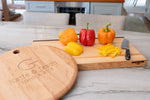
Charcuterie Boards v. Cutting Boards
, by Shelley Swanson, 3 min reading time

, by Shelley Swanson, 3 min reading time
When shopping for a new cutting board, customers often ask about the difference between cutting boards and charcuterie boards. It’s a great question! Let’s sort out the differences together.
Charcuterie boards (also called serving boards or cheese boards) are made from face grain wood, making them more delicate and prone to knife marks. Dull cheese knives are fine for charcuterie boards, but you should steer clear of sharp knives.
Cutting boards (also called butcher blocks) are made from edge grain or end grain wood. This means they can withstand lots of slicing, dicing, and chopping. And bonus: a cutting board can double as a charcuterie board or a grazing board, giving you more bang for your buck.
Another great question! Wood has three sides of grain: (1) face grain, (2) edge grain and (3) end grain.
Face grain is typically the widest side of the lumber. This is where you see most of the wood’s unique character and grain pattern. But when you cut on the face grain, you are slicing against the grain’s fibers which will leave knife marks. This is why face grain wood is used mostly for serving boards and tabletops.
The edge grain and end grain sides are more durable because the grain pattern is less exposed. This is why cutting boards are typically made by gluing up long strips of edge grain or end grain wood. (Check out our post on Edge v. End Grain.)

When deciding whether to buy a cutting board or a serving board, consider three factors: (1) General Purpose (2) Weight, and (3) Budget.
If you already have a cutting board, and you plan to use the new board for serving (think cheese knives), then go with a serving board. There are many beautiful wood serving boards in all shapes, sizes, and colors. Find one that speaks to your entertaining needs.
If you’re looking for a board to be used with food prep (think sharp knives to chop onions) go with a traditional cutting board. It will an all-around workhorse in the kitchen… plus you can use the backside as a serving board. We do not put feet on our cutting boards, so you always get two boards in one!
Serving boards are typically ¾”-1” thick, while cutting boards are 1.25” or thicker. If thinness or weight is an important factor, go with a serving board for a lighter option. If you want to also use it for chopping, go for it! Your serving board might show knife marks, but it will be loved. And that’s the most important part.
Another option is to go with a smaller cutting board. We offer cutting boards in a variety of sizes. One of our favorite boards is the Short Round. This 10″ cutting board it is the perfect companion piece in any kitchen large or small.
If budget is a factor, well good news. We have lots of great serving boards AND cutting boards to fit any budget. Many of our serving boards are priced between $30 and $75. The Acadia and Somerville are two customer favorites for $45-50.
Considering a cutting board? The Short Round is also only $45, making it a powerful little workhorse for the same price! The Sand Hills cutting board starts at $80 and is a fine choice for any kitchen.
Wood serving boards and cutting boards are both nice options. If you’re torn between the two, think about how you plan to use the new board, what size you will need and how much you want to spend. Then shop around till you find the right fit…and enjoy!
Our site uses cookies. By clicking accept you agree with our terms of service and privacy policy.